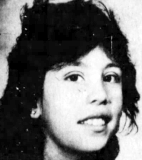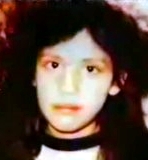9-year-old was last seen in family apartment in Gallup in 1986

www.abqjournal.com
Holding out hope for girl who vanished 30 years ago
By Joline Gutierrez Krueger / Journal Staff Writer
Published: Wednesday, April 6th, 2016
She was 9, but already she had assumed much of the responsibilities of caring for her two younger sisters.
“The story I always heard was that Anthonette was like our mommy,” recalls Wendy Montoya, the youngest sister. “She made sure all our clothes were ironed for the week, made sure we were fed and the house was clean. When our mom went out, we usually had adult supervision, but a majority of times it was my sister helping the baby sitter take care of us.”
So perhaps it was not surprising that when the knock on the door came in the middle of the night to the family’s apartment just off Route 66 in Gallup it was Anthonette Christine Cayedito who answered it. That was the last time Montoya and her family saw her. That was 30 years ago today.
“I remember the police asking me what happened, and I had thought then that it was one of our uncles at the door. That turned out not to be true,” she says. “Really, I’m not sure what happened to her.”
That’s understandable. Montoya was 5 when her sister disappeared.
As the story goes, mother Penny Cayedito had gone out and arrived home to the family’s apartment at 204 Arnold St. around midnight April 6, 1986. She sent the baby sitter home and went to bed before 3 a.m. Sometime in those early hours came the knock on the door, but she slept through it. She didn’t notice Anthonette was missing until around 7 a.m. when she woke up the girls for Bible school.
Despite an intensive search, relatives, neighbors and Gallup police could find no trace of Anthonette.
A year after she disappeared, Gallup police reported receiving a phone call from someone with a young voice claiming to be Anthonette and saying she was in Albuquerque. Before the call could be traced, the voice of an angry man was heard shouting, “Who said you could use the phone?” Then came the sound of a scuffle, a scream, nothing.
Four years later, a waitress in Carson City, Nev., about 870 miles northwest of Gallup, reported seeing a girl in her early teens seated with a couple she described as “unkempt.” The girl, the waitress told investigators, repeatedly dropped her fork. Each time the waitress retrieved the fork, the girl squeezed her hand. Later, after the threesome left, the waitress found a note scrawled on a napkin hidden under the girl’s plate. “Help me! Call police,” it said.
Nothing came of the waitress’ story.
Over the years, other efforts have been made to find Anthonette. In 1992, the TV show “Unsolved Mysteries” re-enacted her disappearance. Penny Cayedito looked to her Navajo culture and consulted medicine men and women about her missing daughter.
The case remains open, a box of files kept in the office of Gallup police Lt. Rosanne Morrisette.
“We have several cold cases, but this is a child,” she says. “Every time a new detective comes on, they go through the case to see what we might have missed. Unfortunately, there have been no leads, no tips that have led anywhere.”
No answers and no Anthonette devastated Montoya’s family – and Montoya. “It just broke my whole family up,” she tells me in a phone call from Bakersfield, Calif., where she lives with her own family. “It was a very dark and dysfunctional time.”
Montoya says she and her mother could barely speak of Anthonette without crying, and then without drinking and getting high. “That was how we coped with the pain, to numb it, not to forget about it but to put it on the shelf, you know?” she says.
News accounts say that investigators believe Penny Cayedito knew more about her daughter’s disappearance than she had revealed and that she had failed a lie-detector test. She died April 18, 1999, two weeks and 13 years after Anthonette’s disappearance, whatever secrets she might have held dying with her.
Montoya became estranged from her middle sister. She fell deeper into drugs, alcohol and gangs and was in and out of the criminal justice system. She lost custody of her children. She thinks the loss of her sister contributed to her tumble into that hopeless abyss.
About nine years ago, Montoya says she decided she needed to crawl back from the bottom. If she could not find her sister, she says, she could at least find herself.
“I went into rehab,” she says. “I struggled to get my kids back, struggled to get away from the old person I was, to break the cycle I was raised up in, and to get far away from here. And I did it.”
Still, the loss of her sister haunts her. She sees her face in every crowd – except she is not even sure what that face looks like now. For her, Anthonette is forever frozen at age 9, a little girl with a jumble of teeth, soft brown eyes and a caregiver’s heart. She is the one they called Squirrel, the one who loved the color purple and Ronnie Milsap, the one who took care of her like a mother when their mother could not. At least, this is what Montoya believes is true.
“I really don’t want to lie and say I remember everything about her. I don’t,” Montoya says. “I just go off the picture and off the stories I was told as the years go by. I really don’t know her. It hurts me. Thirty years is a long time not to know who your sister was.”
She hopes that Anthonette is still out there and that there is still time to find out.

 www.missingkids.org
www.missingkids.org



























